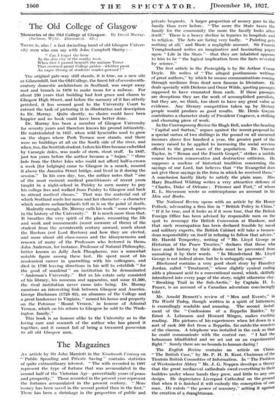The Old College of Glasgow
Memories of the Old College of Glasgow. By David Murray. (Jackson, Wylie. Illustrated. 42s.) 'THERE is, alas a fast dwindling band of old Glasgow Univer- sity men who can say with John Campbell Shairp :— " Can I forget the hour
In the dim city of the murky west, When first. I passed beneath the antique Tower That crowned gaunt College gables—whither pout An eager throng of students scarlet-gowned ?"
The original gate-way still stands, it is true, on a new site at Gilmorehill, but the Old College, the finest bit of seventeenth- century domestic architecture in Scotland, was swept away root and branch in 1870 to make room for a railway. For about 250 years that building had lent grace and charm to _ Glasgow High Street, and before the memory of it has utterly perished, it has seemed good to the University Court to entrust the task of picturing it in illustration and description to Dr. Murray. Quite shortly, no choice could have been happier and no book could have been better done.
Dr. Murray has been a member of - Glasgow University
for seventy years and therefore knows his ground intimately. He matriculated in 1857, when wild- hyacinths used to grow on the slopes where Park Terrace now stands, and there were no buildings at all on the South side of the river, and
• when, too, the Scottish student, before his fibre became enfeebled • by Carnegie doles, was made of stern, stout stuff. In 1847, just ten years before the author became a " bajan," "three lads from the Outer Isles who could not afford half-a-crown a week [for lodgings] came to Glasgow in a smack, moored it above the Jamaica Street bridge, and lived in it during the session." In his own day, too, the author notes that "One of the most eminent medical practitioners of' recent years
• taught in a night-school in Paisley to earn money to pay his_ college fees and walked from Paisley to Glasgow and back to attend medical classes." That was the material out Of which Scotland made her name and her character--a character which modern melancholiasts tell us is on the point of death.
Modestly enough, Dr. Murray calls his work" some chapters in the history of the University." It is much more than that. It breathes the very spirit of the place, recounting the life and work and amusements (scant measure of them) of the student from the seventeenth century onward, much about the Rectors (not Lord Rectors) and how they are elected, and more about old class-rooms and the idiosyncrasies and renown of many of the Professors who lectured in them. John Anderson, for instance, Professor of Natural Philosophy, -better known as Jolly Jack Phosphorus, was a somewhat notable figure among these last. He spent most of his .academical career in quarrelling with his colleagues, and died in 1796 leaving directions in his will to establish "for .the good of mankind" an institution to be denominated "Anderson's University." But as his estate only consisted of his library, his museum and apparatus, and some 11,500, the rival institution never came into being. Dr. Murray mentions an interesting link between Glasgow and America. George Buchanan (1728-62), an alumnus of the College and
• a great landowner in Virginia, "named his house and property .on the Potomac 'Mount Vernon,' in honour of Admiral . Vernon, which on his return to Glasgow he sold to the Wash- ington family."
. This book is an honour alike to the University as to the loving care and research of the author who has pieced it together, and it cannot fail of being a treasured possession to all old Glasgow men.










































 Previous page
Previous page